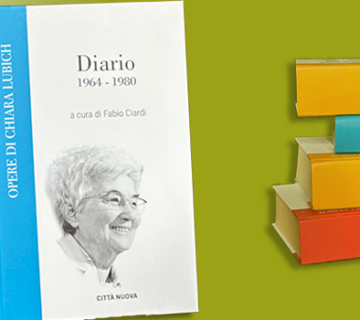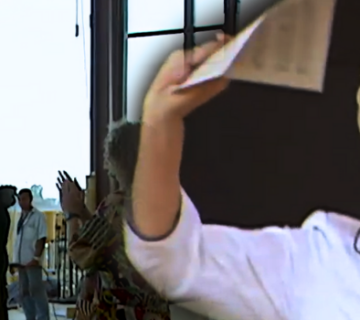 “Ciao Chiara! What a joy it is to live this afternoon with you.
“Ciao Chiara! What a joy it is to live this afternoon with you.
Do you remember the phrase I wrote to you on that 16th December, a few hours after the motorcycle accident which, at 18 years of age, brought me so close to death? “I never thought it to be so wonderful to be completely touched by the love of God …”.
There the mystery of my life was not only revealed but fulfilled. Those words expressed my amazement at experiencing peace through the grace of God’s love for me. And it’s this amazement that, in all these years, has nourished my creativity, my way of expressing myself and also my new physical situation. It was such an unexpected development!
One morning as I was combing my hair in front of the mirror, I felt a sudden surge of happiness. I asked myself which was more true: that three quarters of my body couldn’t move or that my arms could still do acts of generosity. Both of these things were true and they had the same value. Therefore, in me there was unity and with it the perception of complete psycho-physical integrity. And even though I lived in flesh and blood every limitation dependent on my condition, my identity was intact. I was One in myself! That day I said to myself: “Every fibre of every muscle which is still functioning must be used to love.”
Later on, bewildered and astonished as to why I experienced joy despite the innumerable difficulties, I understood Jesus in his cry: “My God, my God why have you forsaken me?” This is what attracted me when I first got to know the ideal of unity some years before the accident. It seemed as though Jesus was giving me proof of this paradox. In virtue of living reciprocal love in a dynamic way, it was possible to harness limitations and abilities in a positive and constructive way, as in “a game of love”.
Through wisdom, the condition of a person with a physical disability is seen in a new light. While many might see in it only suffering, a tragic circumstance to be pitied, a social welfare case, copious tears, it actually becomes not only liveable and saintly, but also a real opportunity to transform society. Every disability, looked at from a new perspective, is an opportunity to embrace that cry of Jesus.
 Modern scientific theory considers “disability” as something that represents the socialisation of problems and needs. Since this is known and accepted, it must be loved by society by altering its structures to accommodate Jesus present in every person. This brings about the necessity for town planning and architecture – which I like to describe as mother sciences – to bring back Jesus in “his city,” the place where personal relationships exist.
Modern scientific theory considers “disability” as something that represents the socialisation of problems and needs. Since this is known and accepted, it must be loved by society by altering its structures to accommodate Jesus present in every person. This brings about the necessity for town planning and architecture – which I like to describe as mother sciences – to bring back Jesus in “his city,” the place where personal relationships exist.
The “handicap” – which is always a social discomfort born from the fateful relationship between the person’s disability and society’s refusal of that disability, the “non-love” – is longer there since the disability is accepted by those who bear it and it is loved and accepted by society which is thus not only renewed but is all-embracing of the suffering of the humanity of Jesus.
So the suffering of a disability loved by those who bear it, and loved by society, in a way eliminates the handicap and this reciprocal relationship transforms suffering into a gentle and light yoke, but it is also a source of light and a spark of true social transformation.
You know, Chiara, over the past 42 years, in every suffering, I have never found a cross that was empty; Jesus was always there – my Jesus, your Jesus. The revolutionary is God himself. Goodbye, Chiara!”
Beppe Porqueddu is a rehabilitation technologist. He conducts Peer Counselling training courses for doctors, rehabilitation personnel, architects and town planning engineers, and for people with disabilities. He is a consultant/project manager for government initiatives on issues of accessibility in cities and parks. He is a coordinator of SIVA (Aid Assessment and Information Services) of the Don Carlo Gnocchi Foundation of Rome. He is also co-founder and current president of “Centro Studi Prisma” in Belluno, in the area of interdisciplinary study of technical and social integration of people with disabilities.


 Italiano
Italiano Español
Español Français
Français Português
Português



No comment